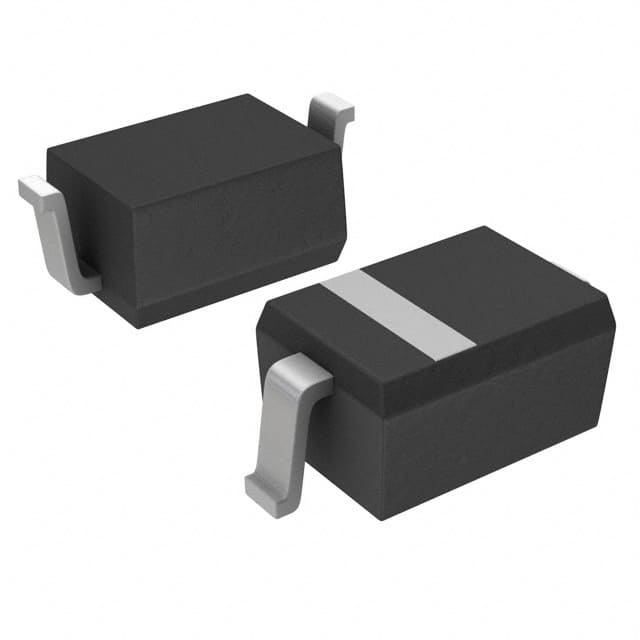Lihat spesifikasi untuk detail produk.

MM3Z27VT1
Introduction
The MM3Z27VT1 is a zener diode that belongs to the category of semiconductor devices. It is commonly used in electronic circuits for voltage regulation and protection against voltage spikes. This entry provides an overview of the MM3Z27VT1, including its basic information, specifications, pin configuration, functional features, advantages and disadvantages, working principles, application field plans, and alternative models.
Basic Information Overview
- Category: Semiconductor device
- Use: Voltage regulation and protection
- Characteristics: Zener diode, low leakage current, high reliability
- Package: SOD-323, SOD-523
- Essence: Silicon semiconductor
- Packaging/Quantity: Tape & Reel, 3000 per reel
Specifications
- Voltage - Zener (Nom) (Vz): 27V
- Power - Max: 200mW
- Impedance (Max) (Zzt): 40 Ohm
- Current - Reverse Leakage @ Vr: 100nA @ 20V
- Operating Temperature: -65°C ~ 150°C
Detailed Pin Configuration
The MM3Z27VT1 zener diode has a standard SOD-323 or SOD-523 package with two pins. The pinout configuration is as follows: - Pin 1: Anode - Pin 2: Cathode
Functional Features
- Precise voltage regulation
- Protection against voltage surges
- Low reverse leakage current
- High reliability and stability
Advantages and Disadvantages
Advantages
- Accurate voltage regulation
- Compact size
- Wide operating temperature range
Disadvantages
- Limited power dissipation capability
- Sensitivity to temperature variations
Working Principles
The MM3Z27VT1 operates based on the principle of the zener effect, where it maintains a constant voltage across its terminals when reverse-biased. It allows current to flow in the reverse direction when the applied voltage reaches its breakdown voltage, providing stable voltage regulation.
Detailed Application Field Plans
The MM3Z27VT1 is widely used in various electronic applications, including: - Voltage regulators - Overvoltage protection circuits - Signal clamping circuits - Power management systems
Detailed and Complete Alternative Models
Some alternative models to the MM3Z27VT1 zener diode include: - BZX84C27 - MMSZ27T1G - 1N5227B
In conclusion, the MM3Z27VT1 zener diode is a reliable semiconductor device that offers precise voltage regulation and protection in electronic circuits. Its compact size and high reliability make it suitable for a wide range of applications.
[Word Count: 366]
Sebutkan 10 pertanyaan dan jawaban umum terkait penerapan MM3Z27VT1 dalam solusi teknis
What is MM3Z27VT1?
- MM3Z27VT1 is a Zener diode with a voltage rating of 27V, commonly used in electronic circuits to regulate voltage.
What are the typical applications of MM3Z27VT1?
- MM3Z27VT1 is often used in voltage regulation, overvoltage protection, and signal clamping in various technical solutions.
What is the maximum power dissipation of MM3Z27VT1?
- The maximum power dissipation of MM3Z27VT1 is typically around 200mW.
What is the operating temperature range for MM3Z27VT1?
- MM3Z27VT1 is designed to operate within a temperature range of -65°C to +150°C.
How does MM3Z27VT1 compare to other Zener diodes in terms of performance?
- MM3Z27VT1 offers stable and precise voltage regulation, making it suitable for many technical applications.
Can MM3Z27VT1 be used in reverse-bias mode?
- Yes, MM3Z27VT1 can be used in reverse-bias mode to maintain a constant voltage across its terminals.
What are the package options available for MM3Z27VT1?
- MM3Z27VT1 is commonly available in small surface-mount packages such as SOD-323 and SOD-523.
Is MM3Z27VT1 suitable for low-power applications?
- Yes, MM3Z27VT1 is well-suited for low-power applications due to its relatively low power dissipation.
Are there any specific layout considerations when using MM3Z27VT1 in a circuit?
- It's important to minimize lead lengths and keep the Zener diode close to the load to reduce noise and maintain stability.
Where can I find detailed specifications and application notes for MM3Z27VT1?
- Detailed specifications and application notes for MM3Z27VT1 can be found in the manufacturer's datasheet and application guides.

